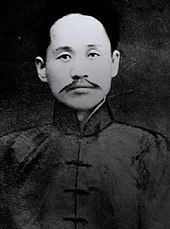Anarchism in Korea
The anarchism in Korea is the Korean independence movement under the Japanese occupation in the early 20th century back. The Korean anarchists banded together across national borders, but their efforts were hampered by regional conflicts and world wars.
history
The Japanese occupation of Korea in 1910 fostered a national liberation movement whose more radical proponents moved towards anarchism . Japanese anarchists collaborated with and supported Korean anarchists. The Japanese anarchist Ōsugi Sakae had a strong influence on the Korean radicals. In 1921 the Korean anarchist group Heukdo hoe ( 흑도 회 , 黑 濤 會 , German Black Wave Society ) was founded. This was done with the support of Japanese anarchists. The group's newspaper was called Black Wave , whose editor-in-chief was the Korean anarchist Bak Yeol.
Shin Chae-ho , who emigrated to China after the annexation of Korea, wrote the draft of the Korean Revolutionary Manifesto in 1923 , which warned Koreans against replacing one oppressor with another or becoming a society that would exploit another. He urged the revolution not only to abolish foreign rule, but also to provide new freedoms and material improvements. The Korean anarchists called their newspaper Talhwani ( German conquest ) and were in favor of communist anarchism . In exile, Shin Chae-ho joined forces with other Korean anarchists. He then joined the Eastern Anarchist Federation ( kor. 동방 무정부주의 연맹 , 東方 無政府主義 聯盟 ) in 1927 , which had members from China, Japan and Vietnam.
After the end of World War II , Korea was the first Southeast Asian region to develop a sizeable anarchist movement. This was mainly due to state communism in China and the repression in occupied Japan . While the Korean Anarchist Federation spoke out against a united national front before the war, some anarchists joined their government- in- exile in the fight for independence during the war . Some anarchists encouraged an alliance with the government to protect Korea from foreign invaders. Others, however, continued to campaign for a federation of autonomous associations across the country.
Movies
In 2017 the biopic Anarchist from Colony about the anarchist Bak Yeol (also Park Yeol) was published. Director Lee Jun-ik focused on the period from 1923 to 1926, when after the Great Kanto earthquake there were attacks on Koreans in Japan and Park Yeol and Kaneko Fumiko were then imprisoned and charged as scapegoats. Both used the trial to draw attention to the massacre in which around 6,000 Koreans are believed to have been murdered.
literature
- Dongyoun Hwang: Anarchism in Korea. Independence, Transnationalism, and the Question of National Development, 1919–1984 (= SUNY series in global modernity ). State University of New York Press, Albany 2017, ISBN 978-1-4384-6168-7 (English, online [accessed November 15, 2018]).
- George N. Katsiaficas: Asia's unknown uprisings 1. South Korean social movements in the 20th century (= Asia's unknown uprisings . Band 1 ). PM Press, Oakland 2012, ISBN 978-1-60486-457-1 (English).
Individual evidence
- ↑ Steven Hirsch, Lucien van der Walt: Anarchism and Syndicalism in the Colonial and Postcolonial World, 1870-1940: The Praxis of National Liberation, Internationalism, and Social Revolution . 2010, p. 102-110 (English).
- ^ Robert Graham: Anarchism: A Documentary History of Libertarian Ideas . Black Rose Books , Montreal 2013, ISBN 978-1-55164-337-3 , pp. 539 (English).
- ^ A b Robert Graham: Anarchism: A Documentary History of Libertarian Ideas . Black Rose Books, Montreal 2013, ISBN 978-1-55164-337-3 , pp. 540 (English).

